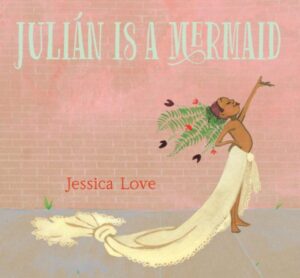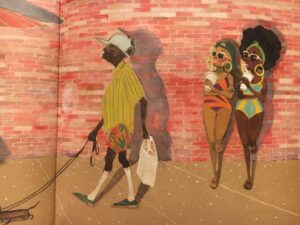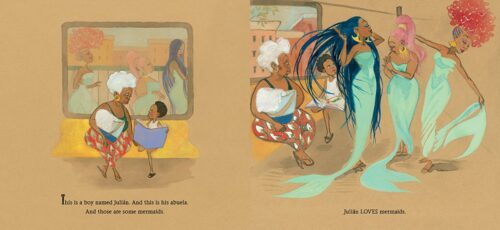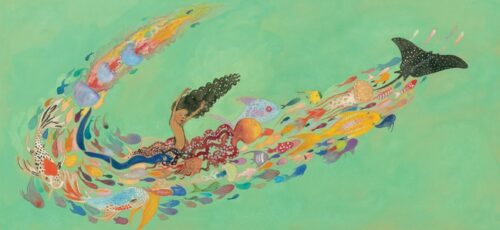Review of the Day: Julián Is a Mermaid by Jessica Love
 Julián Is a Mermaid
Julián Is a Mermaid
By Jessica Love
Candlewick Press
$16.99
ISBN: 978-0-7636-9045-8
Ages 4 and up
On shelves May 22nd
When you walk into another person’s home, there’s always a distinct smell to the place. Homes absorb the lives of their occupants, and the end result is as much an olfactory experience a visual one. I love it when a friend moves house because when I walk into their new home it smells just like their previous place of occupancy, with just a twinge of difference. It is this experience of walking into a house and being overwhelmed by the sense of the place that I hope for in my picture books. When I enter a character’s house I want to almost be able to smell the shampoo in the carpet or the faint aroma of dinner from the night before. Imbuing a book with that kind of realism is beyond difficult, though. You cannot require an illustrator to be able to capture the intangible in their art. That’s why I bide my time and wait. And wait. And wait. And then one day, my waiting is rewarded. A book like Julián Is a Mermaid comes along and there. I can smell the apartment that Julián shares with his abuela. I’m there because Jessica Love has been granted a very remarkable gift. She can make paint reflect reality. Even when it’s a reality that some people refuse to see.
Coming home from the pool with his abuela one day, Julián’s subway car is suddenly boarded by three beautiful mermaids. Their gowns flow like tails, their hair moving like it’s caught the ocean currents, and everything about them is simply wonderful. In short order Julián begins to imagine himself as a mermaid and when he gets home he starts his own transformation. While abuela showers he turns plant fronds into hair, lacey curtains into a tail, and on his lips goes some lipstick. Caught by his grandmother he’s unsure of how to feel. That is, until she leads him by the hand to the Coney Island Mermaid Parade. They join the throng and Julián knows he belongs. With minimal language and an abundance of love, the author/illustrator gives everyone with a mermaid inside of them a tale of sweet, near speechless belonging.
When children’s books break taboos it’s usually done in fits and starts. A book here, a book there. In this case we’re talking about picture books where boys identify with nonconforming ideals of gender identity and beauty. Over the years we’ve seen this tackled in a number of different ways. There’s been Sparkle Boy by Leslea Newman, I Love My Purse by Belle DeMont, Morris Micklewhite and the Tangerine Dress by Christine Baldacchino, Jacob’s New Dress by Sarah Hoffman, Big Bob, Little Bob by James Howe, 10,000 Dresses by Marcus Ewert, and (of course) William’s Doll by Charlotte Zolotow. [No word yet on when we’ll get this many similar titles for girls, but that’s a debate for another day] These books vary considerably in quality from title to title, but they all offer a challenge to society’s demand that boys look and act in a very specific way, and woe betide you if you’re different. The funny this is that even though Julián Is a Mermaid is just the latest in a long line, it feels to me like this is the one I’ve been waiting for all these years. These other books have specific messages, just like Julián, but unlike those books Julián’s story is more than just figuring out who you are. It’s about realizing that you aren’t alone and that there’s a great big welcoming community out there, if only you can find it. And sometimes, just sometimes, it’s just been around the corner from you all along. If those other books laid the groundwork, Julián is taking the message to the next level. It’s like Stephen Sondheim said. “No one is alone.”
A picture book is a conversation between pictures and words. Unless it’s wordless, of course. Then all bets are off the table. In this book, Love works with watercolor, gouache, and ink, and for her story to work much of the action must feel weightless. In a bit of inspiration Love lets us into Julián’s head pretty early on, allowing us to see him and he sees himself in wordless sequences that require no explanation. Interestingly the pictures appear to have been painted on brown paper, which was such an interesting choice. Of course, I got all kinds of distracted by the details Love has hidden along the way. In an early dream sequence, Julián imagines himself receiving a necklace from a large blue fish with white patterned scales. Later in the book, when his grandmother hands him his own necklace, she is wearing a dress made of the same pattern. Now look at the front and back endpapers. At the beginning we see Julián swimming beneath his abuela and her friends in the local pool. At the end of the book he’s reimagined them all as mermaids and the blue of the water, which was confined to the pool edges at the story’s start, has spilled over to fill the entire page.
 And then there are the people. My favorite image in the book isn’t Julián in his mermaid dream sequence (though it is pretty good). It’s not the Mermaid Parade itself or the old ladies in the pool. It’s a simpler spread than all of those. Julián is dressed in his mermaid costume, walking down the street with Abuela, holding onto her arm. He asks “Where are we going?” and is about to pass an old man with high socks walking two wiener dogs and two young women, leaning on a brick wall, sipping something cool, mighty cool themselves. The first time I read this book I just stared at this sequence. Every single person in this picture is a real person. If you followed that old man you’d get to see exactly what his life is like. If you stayed with the girls you’d get wrapped up in the fun and confusion of their world. When Jessica Love illustrates a human being, her brush has weight. That person has life. Abuela herself has seen things. Things that have taught her that life is too short not to allow her grandson to grow to be the person he was meant to be. I think she knows exactly all the problems he may face later in life but on this day she’s going to give him something he can hold onto for a long long time. Something that will be able to sustain him as he grows up. She’s giving him his people. “Like you, mijo”, she says. “Let’s join them.”
And then there are the people. My favorite image in the book isn’t Julián in his mermaid dream sequence (though it is pretty good). It’s not the Mermaid Parade itself or the old ladies in the pool. It’s a simpler spread than all of those. Julián is dressed in his mermaid costume, walking down the street with Abuela, holding onto her arm. He asks “Where are we going?” and is about to pass an old man with high socks walking two wiener dogs and two young women, leaning on a brick wall, sipping something cool, mighty cool themselves. The first time I read this book I just stared at this sequence. Every single person in this picture is a real person. If you followed that old man you’d get to see exactly what his life is like. If you stayed with the girls you’d get wrapped up in the fun and confusion of their world. When Jessica Love illustrates a human being, her brush has weight. That person has life. Abuela herself has seen things. Things that have taught her that life is too short not to allow her grandson to grow to be the person he was meant to be. I think she knows exactly all the problems he may face later in life but on this day she’s going to give him something he can hold onto for a long long time. Something that will be able to sustain him as he grows up. She’s giving him his people. “Like you, mijo”, she says. “Let’s join them.”
I worked in New York City as a children’s librarian for eleven years, and now think I’ll live in the Midwest for, what I suppose will be, the rest of my life. This means I have a superpower. I am capable of reading a book both as a New Yorker, and as a Midwesterner. You have no idea how useful this power is. Things that I would have taken for granted in one part of the country can be seen as potentially baffling in another. Which brings us to the end of this book. Now I lived in New York long enough to be fully aware of the Mermaid Parade of Coney Island. It takes place once a year to welcome in the summer season. People of all stripes get decked out as mermaids or sea creatures or Neptunes and then parade down the wooden boardwalk, right before throwing fruit into the sea. Honestly, if you want to know anything about it you should read Melanie Hope Greenberg’s seminal picture book Mermaids On Parade. But I think it’s easy for people to forget that not everyone knows about this event. When I showed this book to a colleague they interpreted the ending differently than I did. For them, the finale was far more metaphor than reality. The boy’s abuela has taken him to the people that will understand and accept him so that he can discover himself fully. The fact that there is an actual parade out there with actual mermaids is almost superfluous in that light. Nice to see that the book works on multiple levels then.
I read so many picture books in a given week that they all have a tendency to run together in my brain. Maybe that’s why I’m so grateful when something stands out like Julián Is a Mermaid. Not simply because of its subject matter. I mean, I think I’ve shown that this is a road that has been well trod. What stands out here is the art, the characters, and the deeply felt emotions. That moment when Julián has been caught by his grandmother and she leaves him to get dressed is one of the most highly charged instances I’ve seen of someone waiting to find out whether or not what they feel (and, for that matter, who they are) is going to be embraced or denied. There is nothing about this book that is forgettable. In fact, you may have a hard time not thinking long and hard about it after you put it down. A book for mermaids and boys and girls and parents and teachers and booksellers and librarians and . . . aw, heck. Let’s just simplify things and say it’s a book for the human race. Lord knows there are some people out there that will need it. Let’s hope it finds the ones that need it most.
On shelves May 22nd (just in time for the June 16th Mermaid Parade!)
Source: F&G sent from publisher for review.
Like This? Then Try:
- Morris Micklewhite and the Tangerine Dress by Christine Baldacchino
- Big Bob, Little Bob by James Howe
- 10,000 Dresses by Marcus Ewert
The job outlook in 2030: Librarians will be in demand
The job outlook in 2030: Librarians will be in demand
ALREADY A SUBSCRIBER? LOG IN
We are currently offering this content for free. Sign up now to activate your personal profile, where you can save articles for future viewing









Add Comment :-
Be the first reader to comment.
Comment Policy:
Comment should not be empty !!!